Snakes are fascinating and often misunderstood animals. These legless creatures live just about everywhere in the world—some snakes even live in the ocean! The only places where there are no snakes are New Zealand, Ireland, Greenland, Iceland, and Antarctica.
Many people suffer from Ophidiophobia (fear of snakes). However, snakes are critical to keeping the earth’s ecosystems balanced. In addition, of the astounding 3,000 different snake species, only around 600 are venomous.
Snakes come in all shapes and sizes, from the extinct 42-foot-long Titanoboa to the 3-inch-long Barbados thread snake. Many snakes have unique shapes as well, with heads much larger than their thin bodies. Let’s look at 11 snakes with the biggest heads in the world!

11. Rhinoceros Viper
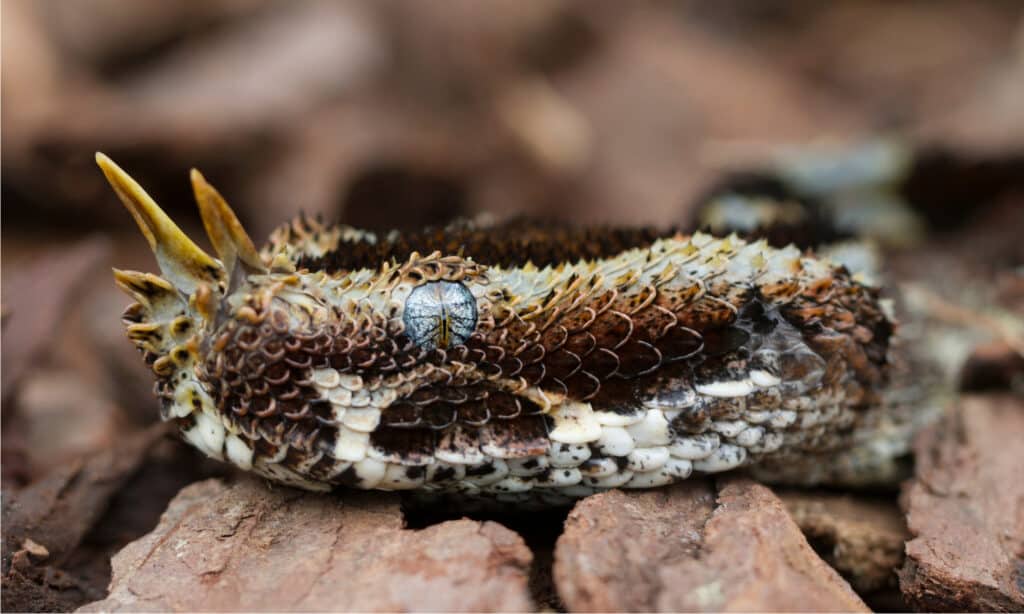
The
rhinoceros
viper typically moves slowly due to its heavy body, but this snake can strike very quickly.
©Mark_Kostich/Shutterstock.com
The rhinoceros viper has a large, triangular head and a very unique nose. Like its name, this snake has two to three pairs of “horns” on the tip of its snout. Rhinoceros vipers are 36-48 inches in length with heavy bodies. Their scales are extremely keeled or ridged, giving these snakes a very bristly appearance.
These unique snakes live in Central Africa in swampy, forested areas with dense vegetation. Rhino vipers have neurotoxic and hemotoxic venom, but since they live deep in the jungle, they rarely encounter or bite humans. In addition, rhinoceros vipers are not very aggressive and avoid human settlements.
This snake is sometimes called a butterfly viper or river jack as well.
10. Bighead Sea Snake
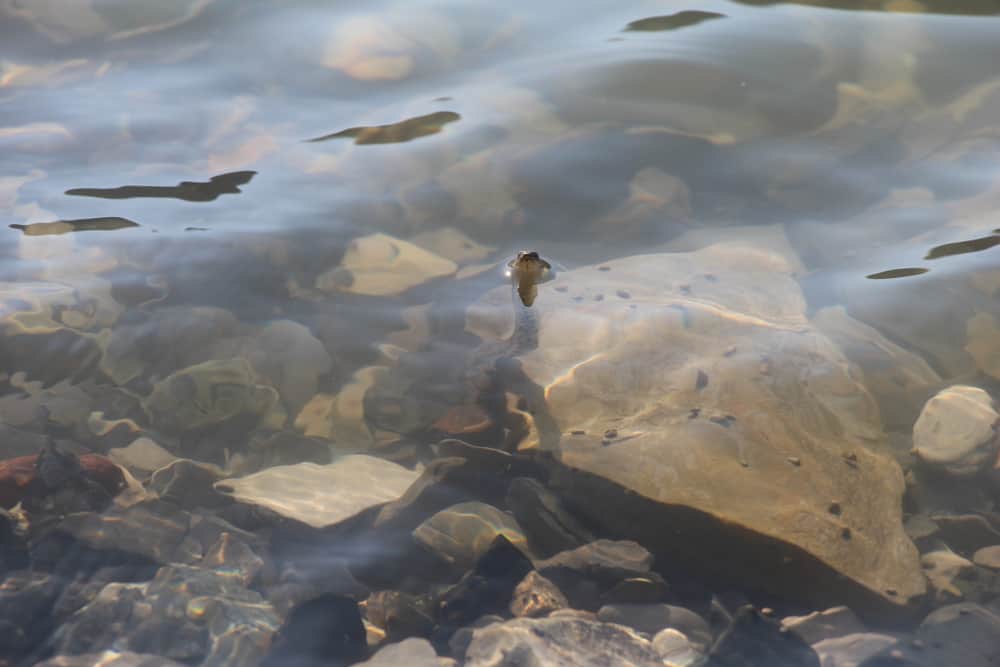
Bighead sea snakes prefer the shallow, muddy waters near the coasts.
©Veron_7_7_7/Shutterstock.com
The bighead sea snake is a smaller snake, measuring only 20 inches in length. However, as its name suggests, this snake has a uniquely large head. Bighead sea snakes are native to the Indian Ocean and live off the coasts of Indonesia, as well as Thailand, Vietnam, Malaysia, Cambodia, and Singapore.
These snakes have grey or blue-grey bodies with darker stripes or crossbands running along their entire length. Bighead sea snakes are also called Annadale’s sea snakes.
9. Dog-Toothed Cat Snake
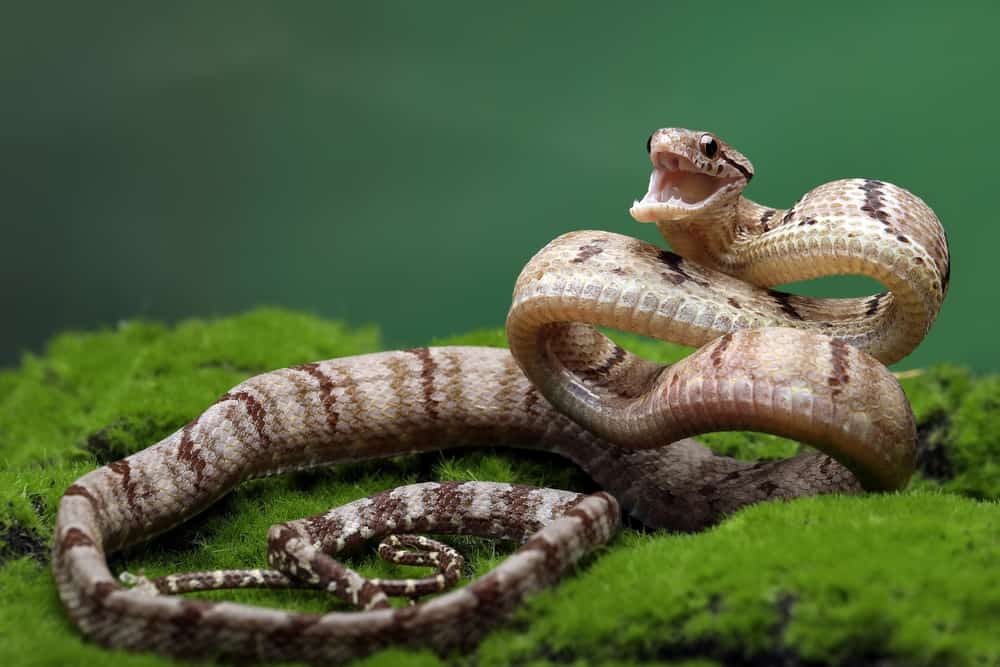
Dog-toothed cat snakes are mildly venomous snakes with rear fangs.
©Lauren Suryanata/Shutterstock.com
The dog-toothed cat snake has a large head that is distinctly bigger than its small neck.
These large snakes can grow up to 78 inches in length with yellowish-brown, reddish-brown, or orange-brown bodies. Their bodies are laterally compressed and slender, with dark bands along their backs that are edged in white. There is also a broad, dark stripe behind each of the snake’s large eyes.
Dog-toothed cat snakes living in Peninsular Malaysia may also have dark mottling that makes them look almost entirely black. These snakes are endemic to Asia, where they live in the trees of lowland forests, as well as on the forest floor.
8. Arabian Horned Viper
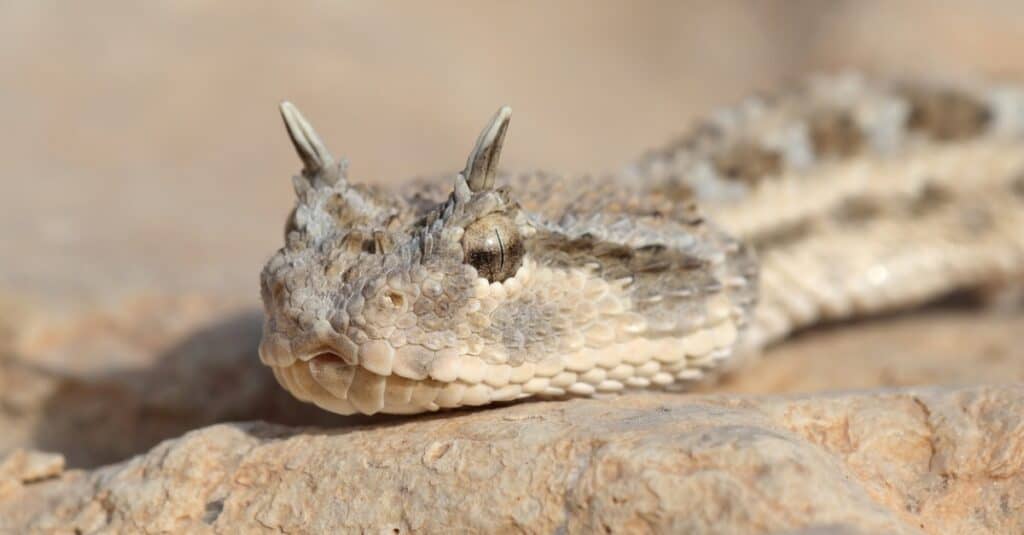
Bites from the Arabian horned viper require hospital treatment, though there have been no fatalities.
©iStock.com/bogdanhoria
The Arabian horned viper has a short body with a large head shaped like a flattened triangle. This snake only measures between 12 and 24 inches, with keeled or ridged scales covering the length of its thickset body. Some Arabian sand vipers also have large, vertical horns above each eye.
During the day, the Arabian sand viper seeks shade under bushes or hides its body in the sand to keep it safe from the sun’s heat. These snakes hunt mostly at night and eat rodents, arthropods, and lizards. Arabian horned vipers live in the Arabian Peninsula and move by “sidewinding” across the desert sands.
7. Cottonmouth Snake
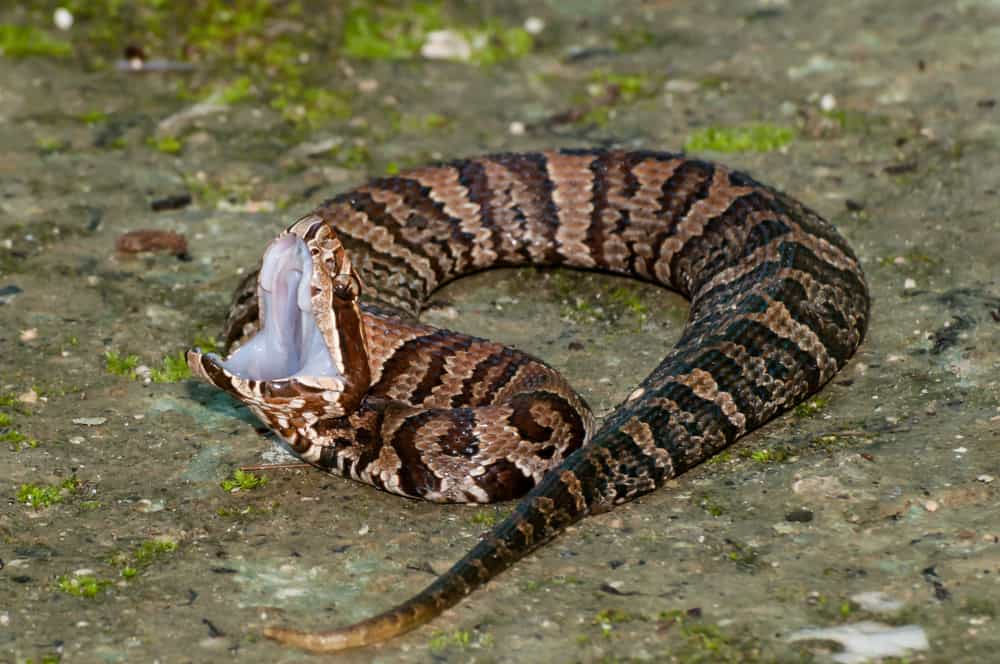
Cottonmouth snakes have thick, muscular bodies measuring up to 6 feet long.
©Jay Ondreicka/Shutterstock.com
The cottonmouth snake is native to the southeastern United States. This semiaquatic viper is an excellent swimmer and primarily eats frogs and fish.
It often lives near shallow lakes and slow-moving bodies of water like streams and marshes. Because of this, cottonmouth snakes are also called water moccasins, swamp moccasins, swamp rattlers, and North American water vipers.
These snakes have broad, bulky heads with blunt snouts and thin necks. Cottonmouth snakes have a powerful cytotoxic venom that destroys tissue. When a cottonmouth snake feels threatened, it will often coil its body and throw its mouth open to display its large fangs.
Cottonmouth snakes have dark, irregular, and wavy crossbands with black edges running along the length of their bodies. These markings can be blackish, brown, tan, grey, or yellowish olive in color.
6. Wagler’s Palm Pit Viper
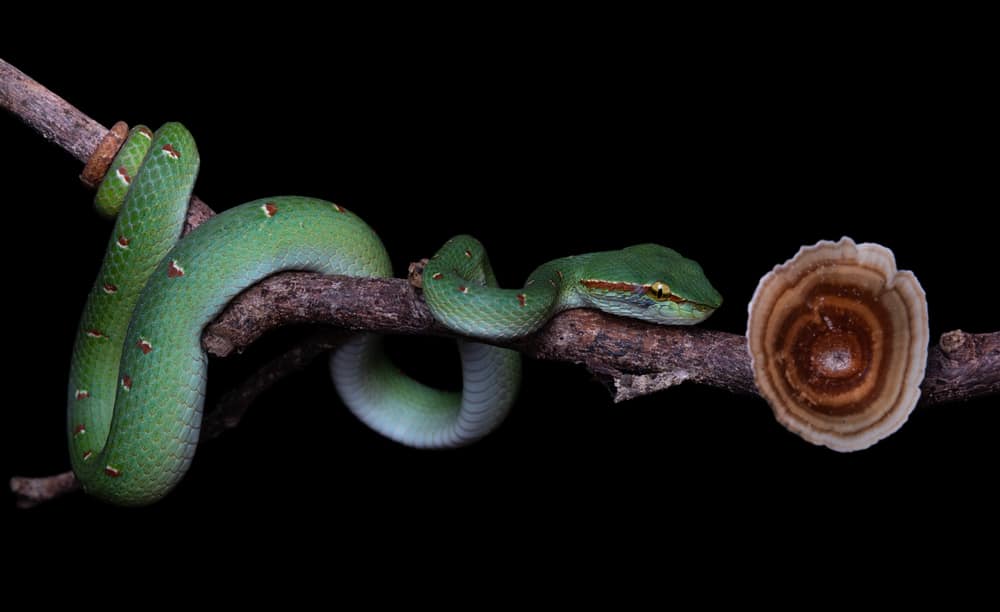
Wagler’s palm pit viper is one of the most common pit vipers in southeast Asia.
©Nenad Preradovic/Shutterstock.com
The Wagler’s palm pit viper has a distinctly large, triangular-shaped head. These are venomous snakes that live in southeastern Asia in lowland forests and mangroves.
Sometimes they are referred to as “temple vipers” because they are common around Malaysia’s Temple of the Azure Cloud. Wagler’s palm pit vipers are arboreal, spending most of their lives in mid-level tree canopies.
These snakes come in a wide variety of colors and patterns. Some have bright green bodies with small red and cream spots or bars along their backs. Others have dark-colored bodies with pale yellow bands.
5. Eastern Hognose Snake
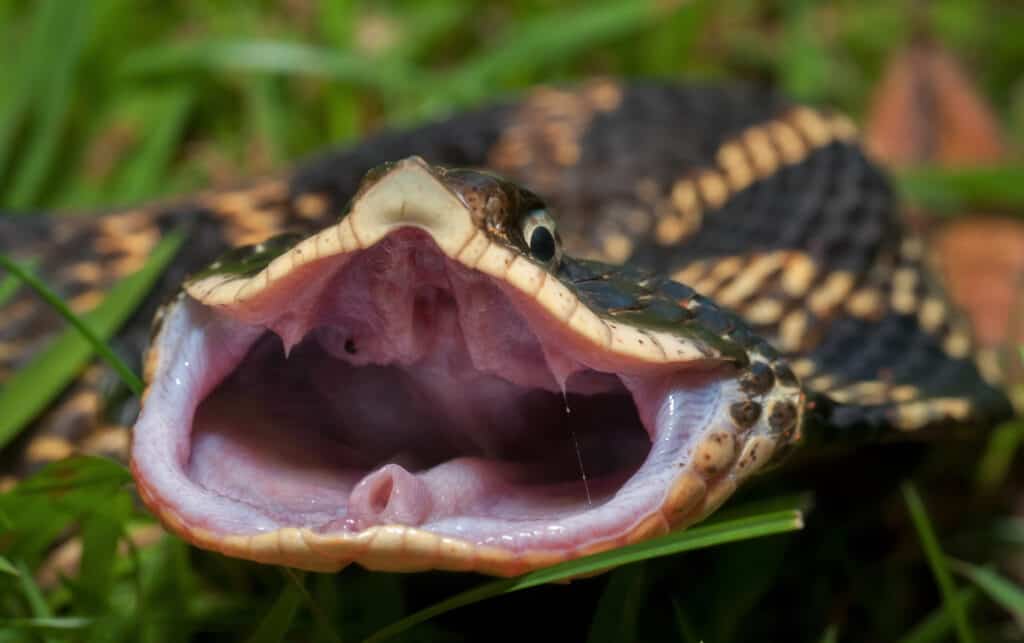
Eastern hognose snakes are known for eating toads.
©Mike Wilhelm/Shutterstock.com
At first glance, the eastern hognose snake appears to have a regular-sized head. However, when this snake feels threatened it spreads its head and neck wide like a cobra, transforming it into a supersized cranium! Eastern hognose snakes live in the eastern half of the United States in fields, forests, prairies, woodlands, coastal areas, grasslands, and river valleys.
They have a uniquely upturned snout that they use to burrow beneath loose sand and soil. Eastern hognose snakes almost exclusively eat amphibians. However, occasionally they may also eat salamanders, invertebrates, birds, and small mammals.
These snakes have thick bodies and grow between 18-48 inches in length. Eastern hognose snakes come in a wide variety of colors and patterns depending on where they live.
4. Copperhead Snake
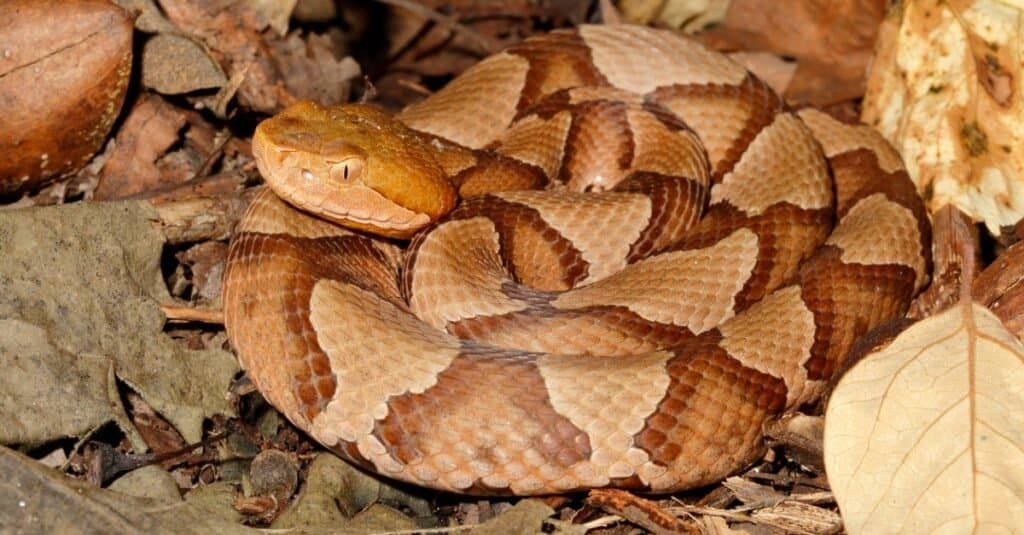
Copperhead snakes have broad, wedge-shaped heads with a coppery-red color.
©iStock.com/David Kenny
As its name suggests, the copperhead snake has a large copper-red head shaped like a broad triangle or arrowhead. These snakes have thick, muscular bodies covered in keeled or ridged scales and typically measure between 24-36 inches in length. Copperhead snakes are often light brown, tan, salmon, or pinkish in color, with dark crossbands along the length of their bodies.
These banded marks are shaped like an hourglass with brown or reddish-brown colors. Copperhead snakes are the only species of snake with these uniquely shaped markings. These venomous snakes live in the United Snakes and northern Mexico and can be found in many different types of habitats.
3. Blunt-Headed Tree Snake

Blunt-headed tree snakes have vertical pupils that help them to make the most of the available light.
©Ryan M. Bolton/Shutterstock.com
The blunt-headed tree snake has an unusually large head in proportion to its extremely thin body. In addition, this snake has very large eyes that take up at least 25% of its head.
Their eyes protrude from the sides of the snake’s head, allowing it to see a wider range than many other snake species. Blunt-headed snakes are nocturnal, so these large eyes also help them to take in as much light as possible to see in the dark.
These are arboreal snakes that live in Central and South America, as well as Mexico. Young snakes may sometimes venture into dense vegetation closer to the ground, but the adults live almost exclusively in trees. Because their necks are so thin, blunt-headed tree snakes mainly eat small reptiles and amphibians, like dwarf geckos, anoles, and frogs.
Although they are mildly venomous, these snakes are docile and do not typically bite humans.
2. King Cobra
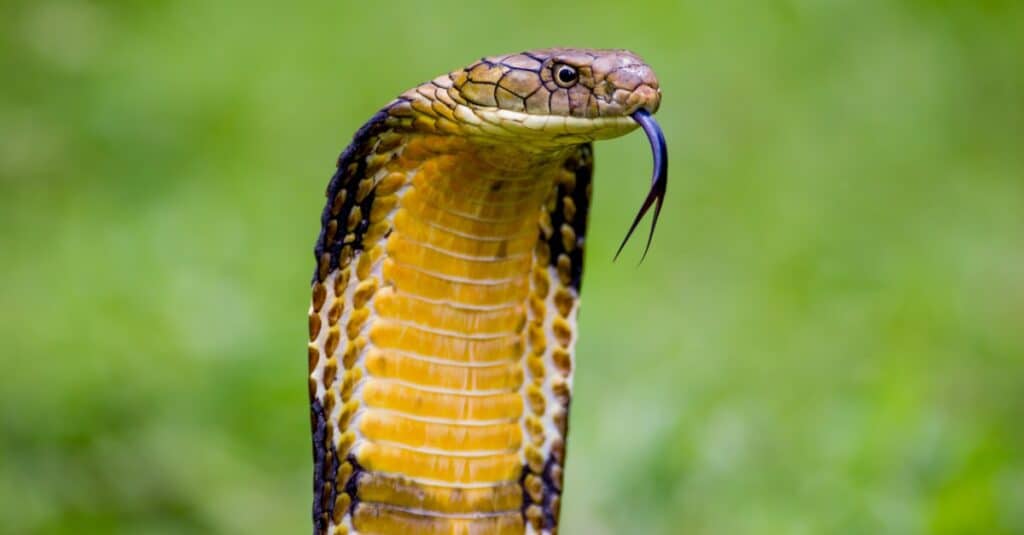
King cobras raise much of their lengthy bodies and “stand up” off the ground.
©iStock.com/takeo1775
The king cobra is a large snake with a large, bulky head. This snake lives in Southeast Asia, southern China, and India. King cobras can be found in a wide variety of different habitats, from rainforests and mangrove swamps to rivers, bamboo thickets, and grasslands.
These snakes are typically between 10 and 13 feet in length but can grow up to 18 feet long! King cobras are not only the longest venomous snake in the world, but they raise much of their lengthy bodies and “stand up” off the ground. These snakes are extremely dangerous, with cytotoxic and neurotoxic venom that can kill a human within 30 minutes!
Fortunately, however, king cobras are typically shy and avoid humans as much as they can. When it feels threatened, a king cobra will hiss and flare out its hood to make it look larger and more intimidating. These unique snakes have lost much of their native habitats and are harvested and persecuted by humans. Because of this, the king cobra is vulnerable to extinction.
1. Gaboon Viper
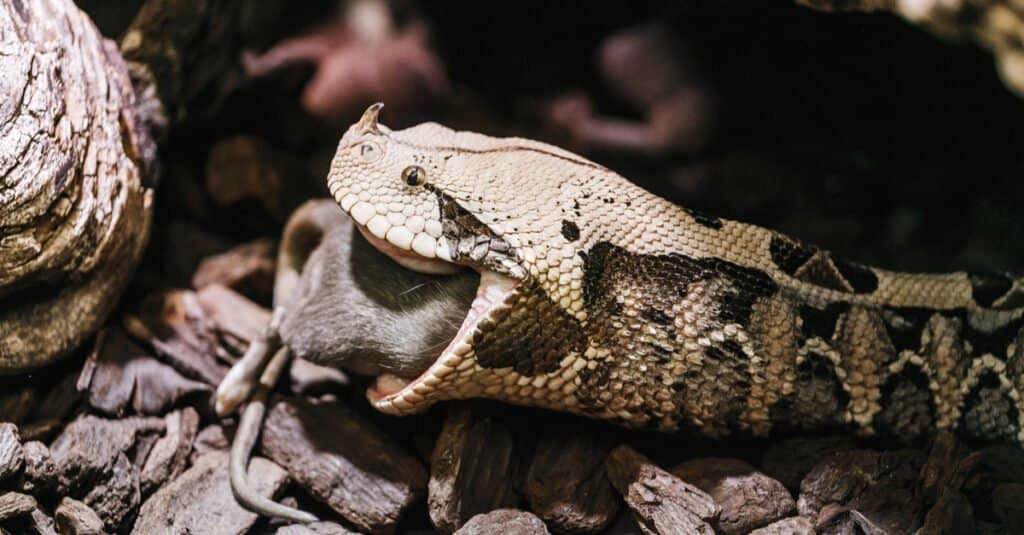
Gaboon vipers’ heads are the biggest of any snake species in the world, reaching up to 6 inches wide.
©frantic00/Shutterstock.com
The gaboon viper has the largest head of any snake in the world, measuring up to 6 inches across! These large snakes can grow between 48-84 inches in length and weigh more than 45 pounds. Gaboon vipers are the largest viper species in Africa and live in rainforests. These snakes have large fangs up to 2 inches long and can produce more venom per bite than any other venomous snake in the world! Their venom is cytotoxic and can cause one of the most painful bites of any snake as well.
The colors and patterns on a gaboon viper provide the snake with excellent camouflage as it patiently waits among the leaves on the forest floor. The snake’s body is patterned with light and dark brown edged in purple and pink scales that form diamond markings and stripes along their backs. The gaboon viper has unique horns on the end of its snout that mimics a fallen leaf, further concealing it in the leaf litter.
Gaboon vipers are passive hunters and conceal themselves in the leaf litter on the forest floor as they wait for small animals to pass by. Although gaboon vipers are sluggish and move very slowly, they can strike faster than almost any other venomous snake in the world.
However, gaboon vipers are surprisingly calm and easygoing. In fact, when a teenage boy kidnapped two gaboon vipers from the National Zoo in Washington D.C. in 1983, neither snake attacked. Both snakes remained calm even in the plastic bag the boy carried as he boarded a bus to go home. However, when the boy was getting off the bus one of the gaboon vipers became agitated and bit him.
Summary of 11 Snakes with the Biggest Heads in the World
| Rank | Snake | Size | Range |
|---|---|---|---|
| 1 | Gaboon Viper | 48-84 inches long with the largest head of any snake, measuring up to 6 inches across | Africa |
| 2 | King Cobra | 10-13 feet long; can grow up to 18 feet | Southeast Asia, southern China, India |
| 3 | Blunt-Headed Tree Snake | Unusually large head in proportion to its extremely thin body | Central and South America, Mexico |
| 4 | Copperhead Snake | 24-36 inches long; large copper-red head shaped like a broad triangle or arrowhead | United Snakes, northern Mexico |
| 5 | Eastern Hognose Snake | 18-48 inches long; spreads its head and neck wide like a cobra, transforming it into a supersized cranium | Eastern half of the United States |
| 6 | Wagler’s Palm Pit Viper | Distinctly large, triangular-shaped head | Southeastern Asia |
| 7 | Cottonmouth Snake | Broad, bulky head | Southeastern United States |
| 8 | Arabian Horned Viper | 12-24 inches; large head shaped like a flattened triangle | Northern Africa, the Middle East |
| 9 | Dog-Toothed Cat Snake | Up to 78 inches long; large head distinctly bigger than small neck | Asia |
| 10 | Bighead Sea Snake | 20 inches long; uniquely large head | Indian Ocean; off the coasts of Indonesia, Thailand, Vietnam, Malaysia, Cambodia, and Singapore |
| 11 | Rhinoceros Viper | 36-48 inches long; large, triangular head | Central Africa |
The photo featured at the top of this post is © Ana Dracaena/Shutterstock.com
Discover the "Monster" Snake 5X Bigger than an Anaconda
Every day A-Z Animals sends out some of the most incredible facts in the world from our free newsletter. Want to discover the 10 most beautiful snakes in the world, a "snake island" where you're never more than 3 feet from danger, or a "monster" snake 5X larger than an anaconda? Then sign up right now and you'll start receiving our daily newsletter absolutely free.
Thank you for reading! Have some feedback for us? Contact the AZ Animals editorial team.






